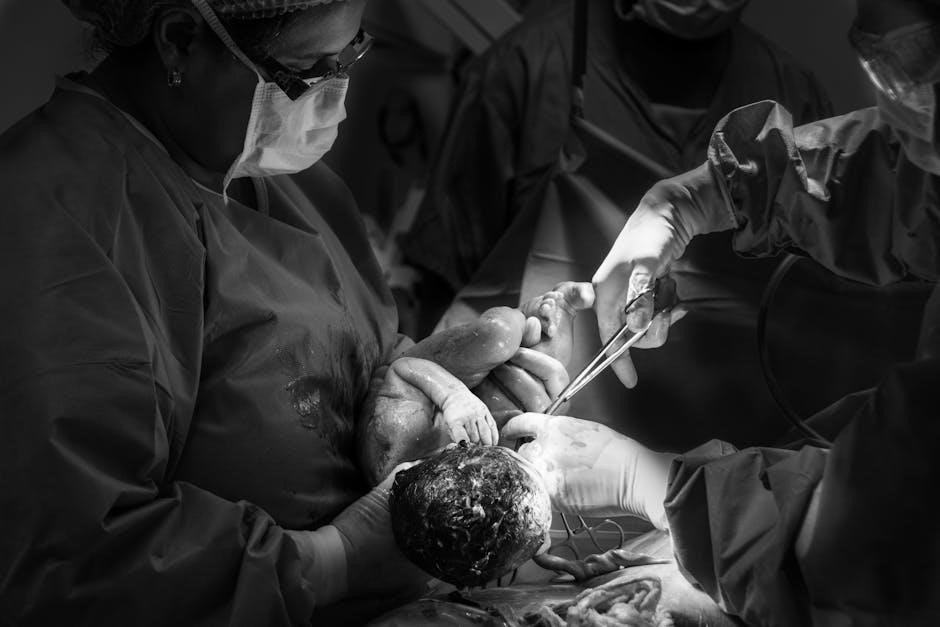Basic Life Support (BLS) is a foundational skill for healthcare providers, focusing on immediate care for life-threatening conditions. The BLS Provider Manual is a critical resource, offering evidence-based guidelines and practical techniques to ensure effective patient care during emergencies. It emphasizes high-quality CPR, airway management, and the proper use of automated external defibrillators (AEDs), providing a comprehensive framework for saving lives and improving patient outcomes.
Overview of the BLS Provider Manual
The BLS Provider Manual is a comprehensive guide designed for healthcare professionals, offering detailed instructions on life-saving techniques. It covers single-rescuer and team BLS skills, emergency recognition, and proper use of equipment like AEDs. The manual serves as a pre- and post-course reference, ensuring providers master high-quality CPR, airway management, and patient assessment. Available in both print and eBook formats, it includes supplementary tools such as the BLS Reference Card, making it an essential resource for effective emergency care training and application.
Importance of BLS in Emergency Care
Basic Life Support (BLS) is crucial in emergency care, as it provides immediate interventions to sustain life until advanced medical help arrives. BLS skills, such as CPR and airway management, significantly improve survival rates by maintaining blood circulation and oxygen supply to vital organs. Proper BLS application ensures the Chain of Survival is effectively initiated, enhancing the likelihood of successful resuscitation and recovery. This makes BLS training indispensable for healthcare providers, equipping them to act decisively in critical situations and save lives.

Structure of the BLS Provider Manual
The BLS Provider Manual is a comprehensive guide, organized to cover BLS techniques, emergency response protocols, and CPR procedures, designed as an essential learning and reference tool.
Key Components of the Manual
The BLS Provider Manual includes detailed sections on single-rescuer and team BLS techniques, chest compressions, airway management, and breathing protocols. It also covers the use of AEDs, emergency recognition, and scene assessment. The manual emphasizes high-quality CPR and adherence to international guidelines, ensuring providers are equipped to deliver effective care in both prehospital and in-facility settings. Additional resources, such as the BLS Reference Card, provide quick access to critical information, enhancing learning and skill retention for healthcare professionals;
Design and Layout for Effective Learning
The BLS Provider Manual is thoughtfully designed to enhance learning and retention. It features clear headings, concise text, and visual aids like diagrams and flowcharts to simplify complex concepts. The manual’s layout ensures easy navigation, with key information highlighted for quick reference. Additionally, the inclusion of a BLS Reference Card provides a portable, quick-reference tool. The digital version offers a searchable format, making it easier for users to locate specific content efficiently. These design elements collectively create an optimal learning experience for healthcare providers.
Core Skills Taught in the BLS Provider Manual
The manual emphasizes high-quality CPR, airway management, and proper use of automated external defibrillators (AEDs). It also covers rescue breathing and chest compression techniques effectively.
Single-Rescuer and Team BLS Techniques
The BLS Provider Manual details techniques for both single-rescuer and team-based care, ensuring effective patient management in various emergency settings. Single-rescuer skills focus on rapid assessment, chest compressions, and airway management, while team BLS emphasizes communication, role delegation, and coordinated efforts. High-quality CPR, AED use, and rescue breathing are highlighted, with practical scenarios to enhance learning. These techniques are adaptable to prehospital and in-facility environments, ensuring seamless application during critical situations.
Chest Compressions, Airway, and Breathing (CAB Sequence)
The CAB sequence is a critical component of BLS, prioritizing chest compressions to maintain blood circulation. Proper hand placement and compression depth are emphasized to maximize effectiveness. Airway management follows, using techniques like head tilt-chin lift to ensure patency. Rescue breathing is then integrated, with a ratio of 30 compressions to two breaths. This sequence is designed to restore oxygenation and circulation efficiently, improving survival chances during cardiac arrest. High-quality CPR, adhering to these steps, is vital for optimal patient outcomes.

Emergency Recognition and Response
Emergency recognition involves quickly assessing the scene and patient condition. Check for breathing, pulse, and responsiveness. Activate the emergency response system promptly and use an AED if needed.
Assessing the Scene and the Patient
Assessing the scene ensures safety for both rescuers and patients. Check for hazards and ensure the area is secure. Evaluate the patient’s responsiveness by speaking loudly and gently stimulating. Look for breathing or gasping and feel for a pulse simultaneously. If the patient is unresponsive, not breathing, or only gasping, and no pulse is detected, begin CPR immediately. Activate the emergency response system or call for help if working alone. This systematic approach ensures timely and appropriate care, maximizing the chance of a positive outcome.
Activation of the Emergency Response System
Activating the emergency response system is a critical step in BLS care. Immediately call for help or send someone to notify emergency services if alone. Provide clear, concise information about the situation. Use of an automated external defibrillator (AED) should be initiated as soon as available. Early activation ensures rapid arrival of advanced care and improves survival chances. The BLS Provider Manual emphasizes this step as part of the Chain of Survival, highlighting its importance in timely medical intervention and effective patient outcomes.

Cardiopulmonary Resuscitation (CPR) Techniques
CPR techniques include chest compressions to circulate blood and oxygen to vital organs, combined with rescue breathing to maintain oxygenation. Proper hand placement is essential for effective compressions, ensuring the chest is compressed to the recommended depth. The CAB (Chest Compressions, Airway, Breathing) sequence is emphasized. High-quality CPR improves survival chances by maintaining blood flow to the brain and heart during cardiac arrest.
Adult, Child, and Infant CPR Procedures
The BLS Provider Manual details age-specific CPR techniques. For adults, the CAB (Chest Compressions, Airway, Breathing) sequence is used, with 30 compressions followed by two breaths. For children, similar steps apply, but compressions are performed with one hand. Infants require two-finger chest compressions and a 5:3 compression-to-breath ratio. The manual emphasizes proper hand placement, depth of compressions, and the use of automated external defibrillators (AEDs) for all age groups. Adhering to these guidelines ensures effective care during cardiac arrest scenarios.
Use of Automated External Defibrillators (AEDs)
The BLS Provider Manual emphasizes the critical role of Automated External Defibrillators (AEDs) in saving lives during cardiac arrest. An AED delivers an electric shock to restore a normal heart rhythm. The manual guides users through key steps: turning on the device, attaching pads correctly, and delivering shocks as prompted. Voice instructions and visual cues ensure ease of use. Early defibrillation, combined with high-quality CPR, significantly improves survival rates. The manual also highlights proper pad placement and the importance of resuming chest compressions immediately after a shock. AEDs are essential tools in both prehospital and in-facility settings.

Airway Management and Rescue Breathing
Airway management is vital for maintaining oxygen supply. The manual guides on clearing obstructions and combining chest compressions with rescue breathing to ensure proper ventilation during emergencies.
Clearing Airway Obstructions
Clearing airway obstructions is a critical skill in BLS, ensuring oxygen can reach the lungs. Techniques include back blows for infants and abdominal thrusts for adults and children. Proper training ensures immediate action to relieve choking, restoring breathing and preventing brain damage. The manual emphasizes quick intervention and adherence to guidelines for effective obstruction removal in both prehospital and in-facility settings.
Combining Chest Compressions with Rescue Breathing
Combining chest compressions with rescue breathing is essential for maintaining blood circulation and oxygenation during cardiac arrest. The BLS Provider Manual emphasizes the CAB sequence: chest compressions first, followed by airway management and breathing. Rescuers should provide 30 compressions followed by two breaths, ensuring minimal interruptions. Proper hand placement and depth of compressions are critical. Training focuses on coordinating these skills seamlessly to maximize oxygen delivery to vital organs, improving the chances of successful resuscitation and patient survival.

Special Considerations in BLS
Special considerations in BLS involve adapting techniques for prehospital and in-facility settings, ensuring high-quality CPR, and addressing unique patient needs to maximize survival outcomes effectively.
Prehospital and In-Facility Settings
Basic Life Support (BLS) techniques differ slightly between prehospital and in-facility environments. In prehospital settings, rescuers often work with limited resources and must prioritize quick assessments and interventions. Scene safety and patient stabilization are critical before initiating care. In contrast, in-facility settings provide more equipment and a team-based approach, allowing for advanced life support integration. Both environments require rapid activation of emergency systems and adherence to protocols. Understanding these distinctions ensures effective care delivery, whether in the field or within a healthcare facility, maximizing patient survival and recovery chances.
High-Quality CPR and Its Impact on Survival
High-quality CPR is essential for maximizing cardiac arrest survival rates. The BLS Provider Manual emphasizes proper chest compression depth, rate, and minimizing interruptions. Research shows that maintaining a compression rate of 100-120 beats per minute and allowing full chest recoil improves blood flow to vital organs. Consistent, high-quality CPR significantly increases the likelihood of successful resuscitation and better neurological outcomes. Adherence to these guidelines ensures that rescuers provide the most effective care, aligning with the latest evidence-based practices to enhance patient survival and recovery potential.

Updates and Guidelines
The BLS Provider Manual incorporates the latest 2020 and 2023 guideline updates, reflecting evidence-based practices to improve patient outcomes. Adherence to these standards ensures high-quality, effective care.
2020 and 2023 BLS Guideline Changes
The 2020 and 2023 updates to the BLS guidelines emphasize evidence-based practices to enhance patient care. Key changes include updated chest compression depths, refined airway management techniques, and expanded use of automated external defibrillators (AEDs). The 2020 guidelines introduced the CAB (Chest Compressions, Airway, Breathing) sequence, prioritizing compressions to improve blood circulation. The 2023 updates further stress the importance of high-quality CPR and team dynamics in emergency response. These revisions ensure providers deliver optimal care aligned with current scientific consensus.
Adherence to International Standards
The BLS Provider Manual aligns with global standards set by organizations like the American Heart Association (AHA) and the International Liaison Committee on Resuscitation (ILCOR). It incorporates universal protocols for CPR, airway management, and AED use, ensuring consistency across different countries and healthcare systems. By following these international guidelines, the manual guarantees that providers worldwide can deliver standardized, high-quality care during emergencies, ultimately enhancing patient outcomes and survival rates.
The BLS Provider Manual is essential for equipping healthcare providers with evidence-based techniques to deliver high-quality care. Continuous learning ensures skill retention and improved patient survival rates.
The Role of the BLS Provider Manual in Lifesaving
The BLS Provider Manual plays a crucial role in lifesaving by providing evidence-based techniques for healthcare providers. It serves as a comprehensive guide for performing high-quality CPR, managing airways, and using AEDs effectively. The manual ensures that rescuers are well-prepared to act confidently during emergencies, adhering to the latest guidelines; By emphasizing continuous learning and skill retention, it supports providers in delivering optimal care, ultimately improving patient survival rates and outcomes in critical situations.
Continuous Learning and Skill Retention
The BLS Provider Manual emphasizes continuous learning and skill retention through structured content and practical examples. It serves as a post-course reference, reinforcing techniques like CPR, airway management, and AED use. The manual’s design allows providers to review and refresh their skills regularly, ensuring competence over time. By adhering to updated guidelines and engaging in periodic training, healthcare professionals can maintain proficiency and deliver high-quality care during emergencies, ultimately improving patient outcomes and survival rates.